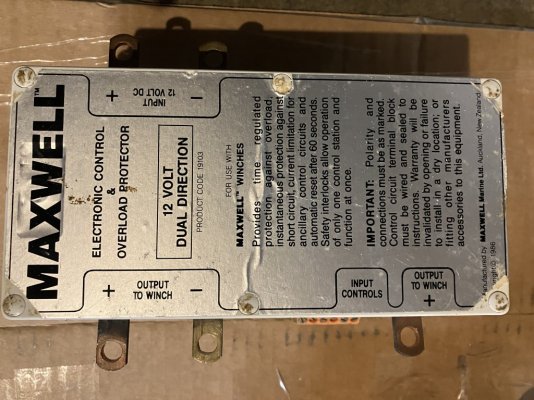SeaDogAK
Senior Member
- Joined
- Aug 9, 2021
- Messages
- 356
- Vessel Name
- Sea Dog
- Vessel Make
- 1991 DeFever 49 RPH
I have an electrical problem with our windlass and I’m hoping someone has some ideas. We have a 1992 Defever 49 RPH, with what I believe is an original Maxwell 2200. There is a breaker at the main electrical panel, and a dedicated Maxwell isolator/breaker unit in the pilothouse, which has a switch and a reset button.
For a while now, it has seemed to get slow with extended use. If we’re halibut fishing with 200’ of chain out, and we have to move a time or two, it runs slower and slower to where I’ve had to wait a while (with engines running) to get the voltage back up. I figured it was the battery - we have a single 8D forward which I believed powered the bow thruster and windlass - which was at least 10 years old, and the thruster didn’t seem to be delivering its usual power either. So I replaced that battery, only to discover that it doesn’t drive the windlass - the windlass apparently is connected to the start bank, which doesn’t seem ideal. There seems to be plenty of power for starting the engines.
Yesterday we were anchored in 150’ of water fishing, and on pulling up the anchor the windlass seemed to be slowing down again. I checked the voltage on the start bank and it was down to 11.4 V. With a few breaks it came back up some, but after a while the windlass quit entirely.
The breaker wasn’t tripped, but the indicator light on the isolator/breaker unit wasn’t lit. Resetting the two breakers did nothing, and the reset button did nothing. The windlass motor was very hot.
I couldn’t figure out any way to restore power. Because we were unable to manually bring up the anchor (a 110’ Bruce with 200’ of chain weighs a lot), I eventually cut it loose.
I suppose the low voltage could have caused the motor to overheat and fry something, but that wouldn’t explain either (1) why we had low voltage in the first place, or (2) why there is now no power at the panel.
I suppose there could be another breaker or fuse that tripped somewhere else that I don’t know about. When we return home I could start tracing wires back with a voltmeter. But I wonder if anyone knows where there might be another breaker or fuse to check. Or any ideas about the original low voltage issue.
For a while now, it has seemed to get slow with extended use. If we’re halibut fishing with 200’ of chain out, and we have to move a time or two, it runs slower and slower to where I’ve had to wait a while (with engines running) to get the voltage back up. I figured it was the battery - we have a single 8D forward which I believed powered the bow thruster and windlass - which was at least 10 years old, and the thruster didn’t seem to be delivering its usual power either. So I replaced that battery, only to discover that it doesn’t drive the windlass - the windlass apparently is connected to the start bank, which doesn’t seem ideal. There seems to be plenty of power for starting the engines.
Yesterday we were anchored in 150’ of water fishing, and on pulling up the anchor the windlass seemed to be slowing down again. I checked the voltage on the start bank and it was down to 11.4 V. With a few breaks it came back up some, but after a while the windlass quit entirely.
The breaker wasn’t tripped, but the indicator light on the isolator/breaker unit wasn’t lit. Resetting the two breakers did nothing, and the reset button did nothing. The windlass motor was very hot.
I couldn’t figure out any way to restore power. Because we were unable to manually bring up the anchor (a 110’ Bruce with 200’ of chain weighs a lot), I eventually cut it loose.
I suppose the low voltage could have caused the motor to overheat and fry something, but that wouldn’t explain either (1) why we had low voltage in the first place, or (2) why there is now no power at the panel.
I suppose there could be another breaker or fuse that tripped somewhere else that I don’t know about. When we return home I could start tracing wires back with a voltmeter. But I wonder if anyone knows where there might be another breaker or fuse to check. Or any ideas about the original low voltage issue.

